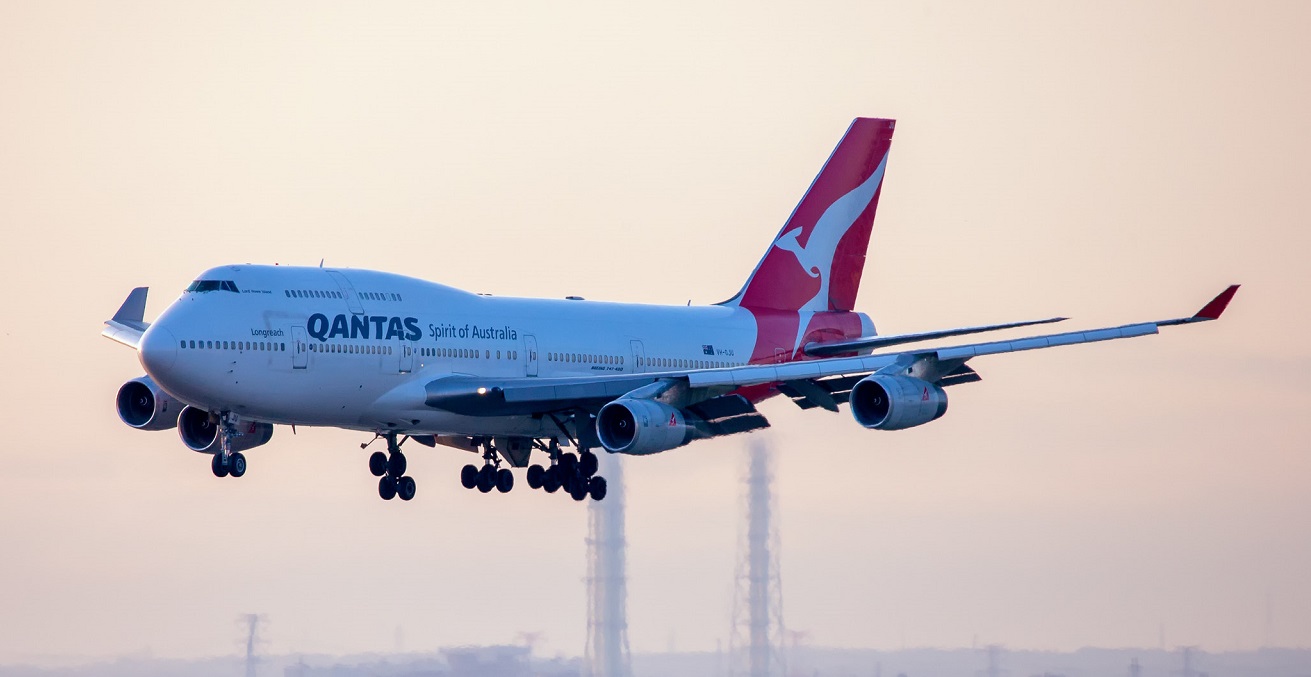Australia Bids Farewell to the Jumbo Jet

With flights grounded and Australia’s borders shut, Qantas has retired its final Boeing 747 several months earlier than initially planned. The jumbo jet was pivotal in reducing Australia’s tyranny of distance.
Australia is remote. With vast overland distances between domestic population centres and oceans on all sides, few places are as well suited to and dependant upon air travel as Australia. All over the world, Australians have a reputation for being passionate and adventurous travellers, and they overwhelmingly arrive at their destinations by plane. In 2019, 64 airlines carried 42.508 million passengers to and from Australia. Of the outbound passengers, 57 percent were Australians going on holiday. The United States, a minimum of 14 hours from Australia by airplane, was the second most popular destination after Indonesia.
Yet Australia’s propensity for air travel is a fairly recent phenomenon. Ocean liners remained the main mode of transportation to and from Australia well into the 1960s. It was the debut of the long-range Boeing 747 in 1967 that began to bring the world closer to Australia and gave masses of Australians the opportunity to see the world. With more seats and greater fuel efficiency than any other aircraft available at the time, the 747 allowed for low enough per-seat costs to put international travel within the reach of the average Australian. Tourism in Australia boomed, and Australians became global citizens.
Recognising its potential, Qantas was an early adopter of the 747. Such was Qantas’ enthusiasm for the jumbo jet that between 1979 and 1985, Qantas operated the world’s only all-747 fleet. During this period, Qantas did not operate any domestic flights under Australia’s two-airline policy. For many adult Australians, their first overseas adventure began in a 747. For hundreds of thousands of people who migrated to Australia in the 1970s, flying aboard a Qantas 747 was their first introduction to Australian culture. Numerous humanitarian missions have been carried out by Qantas 747s, and Qantas claims that its business class services – launched on a 747 – were the world’s first.
Getting to and from Australia has always been a logistical challenge. After departing from England in 1788, the First Fleet spent 252 days at sea before landing at Botany Bay. Convicts endured the journey in the ships’ cargo holds. For much of the 19th century, sailing ships were the most efficient means of arriving in Australia. The journey could take anywhere from two to four months, depending on weather conditions and assuming the ship didn’t wreck, capsize, or catch fire. By the start of the 20th century, with the opening of the Suez Canal and the advent of the steam ship, the voyage from Europe was shortened to 35-40 days and regular service was established between Europe and Australia.
The Kangaroo Route, the Qantas-trademarked nickname for air travel between Australia and the United Kingdom and the inspiration for the flag carrier’s logo, is not simply a patriotic moniker. The name originates from the need for planes to “hop” from one stopover to another along the approximately 21,000-kilometer route to refuel. The first passengers to fly the complete route in 1935 paid the equivalent of A$18,000 for the 12-day, 31-hop journey. By 1947, the Kangaroo Route could be flown in 55 hours, with six hops over the course of four days. Since Qantas began flying 747-400 in 1989, the standard has become just two hops, generally through Singapore or the Middle East, and return economy tickets cost a tenth of what the first passengers paid.
With the advent of ultralong-haul aircraft, hopping over to Europe may become a relic of the past. On 24 March 2018 Qantas debuted regular nonstop service between Perth and London, a mere 17 hours. The pandemic derailed tests for 21-hour nonstop Sydney to London and Sydney to New York routes. The record for longest passenger flight was set by a Qantas 747 flying between London and Sydney in 1989. It was only broken in 2019 by a Qantas 787 Dreamliner flying the same route.
Qantas’ first commercial flight to North America required refuelling stops in Fiji, Canton Island, and Hawaii before reaching San Francisco and Vancouver. The 747 turned hops into leaps in 1982 when Pan Am flew the jumbo jet nonstop from Los Angeles to Sydney for the first time. Qantas began providing regular service on this route in 1984. Travellers now have a choice between half a dozen airlines that offer daily service on routes from Sydney, Melbourne, and Brisbane to Los Angeles, San Francisco, Houston, Dallas, and Vancouver.
The 747 was at the forefront of a second major revolution in international interaction that occurred in the 1960s: the containerisation of shipping. As the designers of the 747 assumed that the aircraft would eventually be superseded by supersonic commercial air travel, designers “future proofed” the 747 by designing it to continue service as a cargo plane. This meant the aircraft needed to be able to easily load and unload the 8 foot by 8 foot by 20 foot shipping container patented in 1956 and adopted by the US military in 1967. The standardized and certified “ISO Container” debuted in 1972 and was quickly adopted by the global shipping industry, leading to an unprecedented boom in international commerce. Getting these containers airborne necessitated two of the 747’s most iconic features: the hump and the hinged nose cone.
The 747’s role as a freight aircraft is more akin to a semi-truck than a container ship. The most recent iteration, the longer, more efficient 747-8F has a larger capacity and longer range than most other freight aircraft currently in service. In fact, Qantas subsidiary Qantas Freight continues to operate two of these aircraft to transport fresh produce, electronics, and mining equipment between Australia, the United States, and China. Though limited by weight, traveling by air is an effective and efficient means of transporting high-value goods. International merchandise trade shipped by air makes up 21 percent of Australia’s total trade by value, and air freight is the critical link between regional Australian farmers and their customers in Asia and throughout the world.
Though the 747 is likely to enjoy a long future as a freighter, the pandemic may signal the end of the jumbo jet era. With borders shut and mandatory quarantine for essential travelers, around 91 percent of 747s and 97 percent of Airbus A380s are parked. Not all of them will fly again. The Qantas 747’s final passenger services were to evacuate of Australians from Wuhan, China and Santiago, Chile, though three joy flights in Sydney, Canberra, and Brisbane allowed enthusiasts and Qantas employees to take one final ride in the “Queen of the Skies.” Qantas’ international flights have been grounded until March 2021.
Yet the use of massive aircraft was already in decline. The 747 was used for only 1.7 percent of the 211,669 international passenger flights that took off from or landed in Australia in 2019. Jumbo jets are notoriously expensive to build and maintain and require almost full capacity to be profitable. Earlier this month, Boeing announced that it would not produce new 747s after 2022. Even the much younger A380’s days were numbered from the day the first one rolled off the assembly line in 2007, long after demand for the 747 had stagnated then dwindled. After only a dozen years, Airbus announced in March 2019 that it would cease production of the massive aircraft. As carriers look to cut costs, governments tighten emissions standards, and consumers become more aware of the environmental impact of air travel, the future favours smaller, more fuel-efficient aircraft.
The final Qantas 747 was given a warm farewell. Hundreds of spectators gathered to see the plane’s final takeoff, commemorated by a water cannon salute. QF7474 to Los Angeles was piloted by Sharelle Quinn, the first woman to captain a Qantas aircraft. As the final Qantas 747 left Australian airspace for the last time, Quinn paid a final tribute to the jumbo jet by flying a course in the shape of a kangaroo. The plane will spend its retirement at the Mojave Air and Space Port in California alongside dozens of other 747s dressed in a myriad of livery.
In 49 years of service, 65 Qantas 747s flew over 3.6 billion kilometers. Qantas CEO Alan Joyce bade farewell to the 747, emphasising, “the Boeing 747 has changed Qantas; it has changed aviation in Australia, it has changed aviation in the world.”
Nancy Schneider is the editor of Australian Outlook. She completed a Masters of International Relations with honours from the Australian National University with a thesis on the factors affecting the level of policy attention granted to global health issues, particularly noncommunicable diseases. Since 2015, she has travelled on virtually every available Australia-Los Angeles route, but has never made the 15-hour trip in a 747.
This article is published under a Creative Commons Licence and may be republished with attribution.





